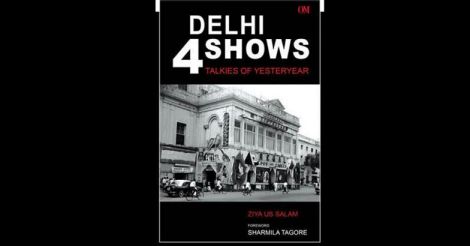In the 1950s, whenever Bollywood stars Raj Kapoor and Nargis visited the Regal, one of the oldest cinemas in Connaught Place here, they used to occupy a particular set of seats, says the theatre's 73-year-old manager.
Movie trivia like this make up the recent book Delhi: 4 Shows: Talkies of the Yesteryear, penned by veteran journalist Ziya Us Salam.
The process of single screen cinemas being replaced by multiplexes is not unique to a particular part of India.
The capital city too has been and continues to be a victim of this development as every Friday, multiplexes across the city swell with movie buffs while single screen cinemas such as Regal in Connaught Place and Jagat beside the Jama Masjid and Ritz at the Kashmere Gate remain deserted.
The book, showcases how the milieu was different in the past.
It captures in nostalgia, the city's hitherto thriving theatre culture and the myriad experiences associated with it.
While cinema itself has undergone a conspicuous change, the experience of movie-going and watching too has altered significantly, from pink moppy tickets being replaced by crisp white ones to the fancy soft drink - nachos combos taking the place formerly occupied by stalls of chai and pakoras.
The book can be assumed to be an articulation of these experiences through stories, some pulled out of the author's own diary, others from cine goers from across the city.
"For people of my generation and those followed up till the 1980s, the film going experience often began with the pleasant anticipation of scanning the newspapers for exciting film ads," says veteran actress Sharmila Tagore in book's foreword. In the same context, the author fondly recalls how as a child he would lavish his weekly pocket money of a rupee on the weekend edition of the English newspaper "Patriot". With films strictly prohibited at his home, he says, "I satiated my appetite for films by looking at insertions in the Patriot."
"Watching films might not be the same today. Multiplexes lack the familiarity and warmth of single screen halls," points out the author.
In the days when Internet was still a distant dream for Delhi, he asserts that cinema in the days of yore, was "a common man's mode of entertainment," and the experience was "impersonal."
"The booking clerk was a much sought after man; even when he was off duty, people would strike up a conversation with him to ensure they were in his good books," he quips.
The sight of suspicious looking men eying the hassled crowd with a smirk on their faces, outside a house full theatre is a familiar one.
The black-marketeers formed an indispensable part of movie going back then.
"They would have a bunch of tickets booked in advance and sold them many times over the market price minutes before the show," says the author.
While black-marketeers still manage to do a decent business in Kolkata, where single screen cinema halls have stood the test of time, in Delhi, they just about eke out a living much like the single screen halls.
To get back at these black-marketeers, he says, "Many were in league with the local paanwala, the hugely popular chaiwala, who would happily keep tickets with them." The book, which offers a panoramic view of 80 such single screen halls in Delhi, which were nothing less than a way of life in their heyday, delves into the histories of these landmark structures.
Sharmila Tagore has described the book as "an ode" and "an elegy" to a bygone era. "By taking this loving, nostalgic look at Delhi's cinema halls, this book preserves the past," says the actress.



































































































































































































































































































.jpg.image.160.84.jpg)





































































































































.jpg.image.160.84.jpg)










































 The book, 'Delhi: 4 Shows: Talkies of the Yesteryear'
The book, 'Delhi: 4 Shows: Talkies of the Yesteryear'
Disclaimer
The comments posted here/below/in the given space are not on behalf of Manorama. The person posting the comment will be in sole ownership of its responsibility. According to the central government's IT rules, obscene or offensive statement made against a person, religion, community or nation is a punishable offense, and legal action would be taken against people who indulge in such activities.